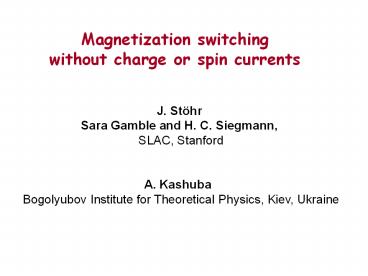Magnetization switching - PowerPoint PPT Presentation
1 / 19
Title:
Magnetization switching
Description:
... E-fields can produce magnetic anisotropy axis magnetocrystalline anisotropy caused by anisotropic ... dominant anisotropy axis and field H E E field ... – PowerPoint PPT presentation
Number of Views:79
Avg rating:3.0/5.0
Title: Magnetization switching
1
Magnetization switching without charge or spin
currents
J. Stöhr Sara Gamble and H. C. Siegmann, SLAC,
Stanford A. Kashuba Bogolyubov Institute for
Theoretical Physics, Kiev, Ukraine
2
Switching with charge or spin currents
- Conventional H field pulses created by current
flow through wires - Time and amplitude limited by
- inductance laws and Joule heat in wires
- Switching with spin polarized currents has same
problem
3
Todays Switching Process 190 years of
Oersted switching.
switching time limited by field strength H and
spin-lattice relaxation time 100 ps
4
Fastest H (B) Field Switching Ballistic
Switching
Patent issued December 21, 2000 R. Allenspach,
Ch. Back and H. C. Siegmann
M
Relaxation into easy axis is governed by
spin-lattice relaxation - but process is
deterministic ! Precise timing for a180o
reduces time
end of field pulse
5
Beyond direct switching by magnetic fields
---- how about electric fields ?
Stöhr et al., Appl. Phys. Lett. 94, 072504 (2009)
6
Magnetic Field is a time-odd axial vector
Magnetic field has same symmetry properties as
magnetization - can
switch magnetization -
Electric Field is a time-even polar vector
Electric field cannot directly switch
magnetization
7
E-fields can produce magnetic anisotropy axis
magnetocrystalline anisotropy caused by
anisotropic atomic positions
bonding fields distort valence charge, create
axis
Ambiguity remains with respect to direction of M
8
The concept of the magnetic anisotropy field
creates direction
2KE
cos ?
HE
M
after some time 100 ps M realigns along HE
butrotation of M limited to lt 90o
9
Cannot switch through rotation of M into HE
Cannot rotate past 90o cannot switch
10
Use Concept of Ballistic Switching pulsed fields
ballistic switching with H field pulse of length
t lt 100 ps
This concept works with E fields, too !
11
Comparison of H and E field ballistic switching
Imagine that E field can create H E fast
12
So what does it take to switch with E-field ?
- Strong enough E field to induce dominant
anisotropy axis and field H E - E field should be at angle ? 45o to
original easy axis - Field pulse has to be fast ( t lt 100 ps)
before M aligns with H E
Process is completely determined by write pulse
length t not by precession and damping time
which may be slower
13
- Two potential methods
- Create new transient anisostropy axis in suitable
multiferroic - by E field pulse optimum angle 45o
- Use strong E field pulse to distort atomic
valence charge - in any material
E
second order Stark effect E 2
Field strength needs to be gt 1 Volt / nm
comparable to valence potential
14
Magnetic writing with SLAC Linac beam
thin Co film on Si wafer premagnetized
100 fs - 5 ps
1nC or 1010 electrons
J. Stöhr and H. C. Siegmann Magnetism From
Fundamentals to Nanoscale Dynamics Springer
Series in Solid State Sciences 152
15
Experiment with ultrastrong fields
electric field strength is up to 20 GV / m (2 V
/ Angstrom)
16
- Magnetic pattern is severely distorted
- --- does not follow circular B-field symmetry
Calculation of pattern with
Landau-Lifshitz-Gilbert theory known magnetic
properties of film, known length, strength,
radial dependence of fields
B-field only
B-field and E-field
17
Magneto-electronic anisotropy is strong E 2
352 or about 1000 times stronger than with
previous 5 ps pulses
B-field torque
E-field torque
18
Use photon pulse instead of e-beam pulse
B field cancels, E 2 field does not cancel
E field only switching should be possible with
THz photons
19
The End































